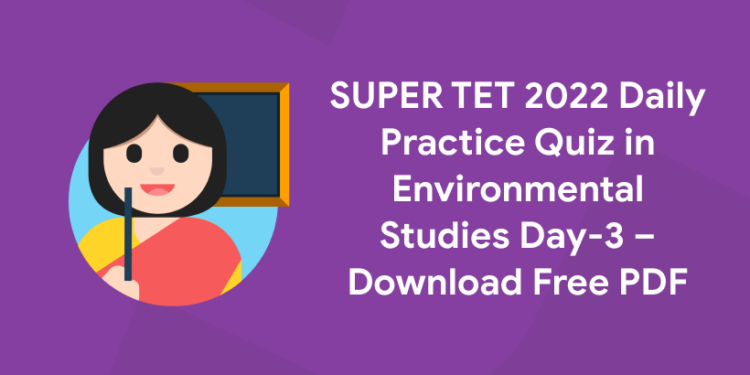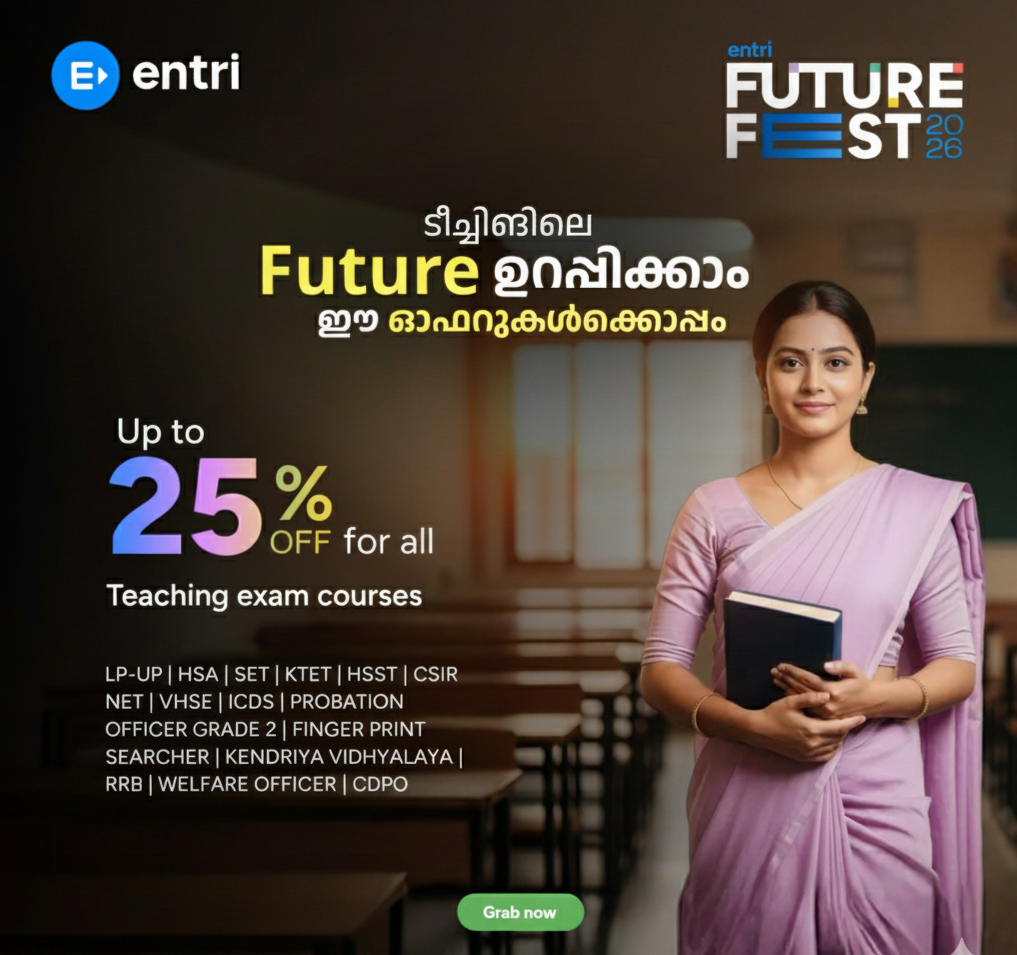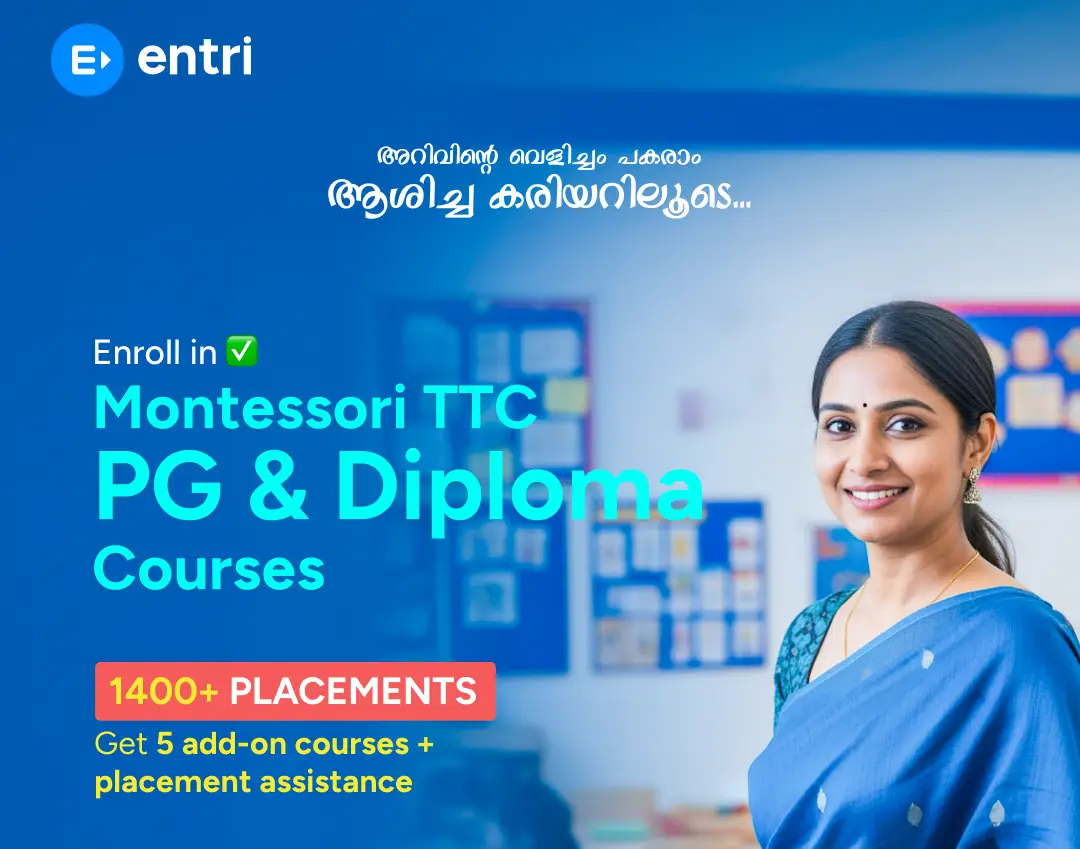The SUPER TET (Super Teacher Eligibility Test) is a national exam to determine your eligibility as a teacher. Government of Uttar Pradesh has issued SUPER TET (Super Teacher Qualification Examination) 2022 for UP supported Middle School Teacher Exam which has a large number of vacancies in UP government. school.
Entri has launched another constructive product for TEACHING aspirants, the SUPER TET Daily Rank Booster, to help you stay one step ahead of your success, quality-based questions, hone your skills and improve your performance in every way imaginable.
Join our Telegram channel for latest updates on SUPER TET Exam 2022
SUPER TET 2022 Daily Practice Quiz in Environmental Studies Day-3
1. As a constructivist teacher how will you plan for integrated EVS class studies?
A) Include two different age group in a classroom for constructive group study.
B) Prepare a lesson plan integrated with science, social science and
environmental studies constructively.
C) Arrange different constructivist teachers for science, social science and
environmental studies separately.
D) Integrate an EVS class for students’ own constructive learning.
Solution
Constructivism is centered on the idea that human knowledge and learning is actively constructed by the learner, not passively received from the environment. Knowledge is always someone’s knowledge. It is created or
constructed by the experiencing individual. It is not impersonal or absolute. Knowledge is created on the bedrock of their prior knowledge. Learners in a classroom have their individual experiences and a cognitive structure, which are built on those prior experiences.
The point to note is that:
- The contents of EVS are organized thematically.
- Topics of both social studies and science are integrated.
- A teacher needs to combine two or more subject areas into one lesson like integrate the concepts and issues of science, social science, environmental education to teach EVS in an integrated manner.
- The syllabus of EVS for class 3rd and 5th integrates the concepts and issues of science, environmental education, and social science because children look at their environment in a holistic manner and
couldn’t differentiate any topic between ‘environment studies’ ‘science’ and ‘social science’. - Transacting EVS (integrated themes) requires teachers to move beyond the individual boundaries of disciplines (their own subject specializations) and plan appropriate learning experiences to help children synthesize multiple perspectives and develop integrated concepts.
- Considering the dynamic nature of children’s learning, the NCF, 2005 has emphasized the concept of dynamic assessment. This is yet another challenge, as it demands teachers to gather more knowledge
about how children think, understand, and relate to the environment, what are the difficulties they encounter, how they carry out EVS activities and projects, etc.
**Hence, we conclude that as a constructivist teacher preparing a lesson plan integrated with science, social science and environmental studies constructively is the best plan for integrated EVS. **
2. Which of the following is not a reason for using storybooks?
A) Stories exercise imagination.
B) A book with stories develops children’s learning strategies.
C) Stories are inspiring, challenging and enjoyable.
D) Listening to stories in the classroom is a political experience.
Solution
A storybook is a teaching material meant for students so that they can read a story by themselves or listen by their parents or teacher. The following are key points related to it:
- Children learn language and learn to read in context. Stories and poems also form interesting contexts.
**Stories exercise imagination. * A book with stories develops children’s learning strategies. * Stories are inspiring, challenging and enjoyable. - While relating a story, a teacher should stop in between and let children complete what would follow.
Many important concepts are natural parts of the stories (for example- big, small, near-far, fat-thin etc.).
Children acquire or consolidate them easily through a story. - The context of the story introduces these and when enacted their meaning gets clearer.
- Besides, the child gets an opportunity to place herself in different characters and in imaginary situations.
- Initially, children mimic and copy only the gross visible features of the characters.
- For example, their way of walking, making sounds etc.
- These may include the jumping as the rabbit, kicking as the horse, wake up call as a cock etc.
- It is these contexts that help children to learn to read.
**Hence, we conclude that “listening to stories in the classroom is a political experience” is not a reason for using storybooks. **
3. Which of the following type of school environment will not make education more effective and will not be conducive to learning?
A) The teaching-learning materials are properly stored and are available in plenty to
children
B) The teacher is friendly and understanding
C) The classroom are spacious with adequate space for free movement
D) The light and ventilation in the classroom is not adequate
Solution
Creating a Learner Friendly Environment: The classroom environment should be such that each and every child feels comfortable, joyful and feel encouraged to use his/ her potentials optimally for learning. For creating
an enabling learning environment, what you need is to look for reasonably comfortable physical conditions of your classroom.
- Physical Environment of the Classroom: A good classroom is like a home away from home for both the teacher and the students. It should thus be safe, secured, attractive and functional, keeping in
mind the grade, age appropriateness, the type of classroom activities the teacher and students will perform etc. A classroom environment communicates a bit good about what the classroom is like. The physical atmosphere of a classroom speaks about the nature of students and teacher of the class. The physical environment of a classroom has two major components: the physical conditions and the material resources available in the classroom. Physical conditions of classroom: The classroom needs to be a part of a pucca building without any leakage in the roof. The walls and floor should be properly plastered without any edges that can cause injury to children. The room is to be well ventilated, and sufficiently
lighted with large doors and windows facilitating cross ventilation which would make the environment of the room comfortable and pleasant for children. **There should be sufficient space available in
the classroom for conducting any group work. Management of TLM: When you are engaged in the management of classroom teaching-learning process, you need quite a large number of
materials like boards (black or white) to write, display boards,materials/furniture for sitting, storing along with the teachinglearning materials (TLM).** Their placement, storage and use in the classroom both by you and your students constitute an essential part of the physical environment of the classroom. - Humane relationship in the classroom: It is observed that the students in their class have good relationship among each other and with teachers, and most students perform better in the subjects
taught by such teachers than in other subjects.
**Hence, we conclude that poor ventilation in the classroom will not make education more effective and will not be conducive to learning. **
4. After having been taught about the rich flora and fauna in India, the students of primary classes were taken to Ranthambhore National Park by the school. This would help the students to
A) co-relate classroom learning to real-life situations
B) develop skills for environmental protection
C) have fun and enjoy with friends on an outdoor trip
D) develop respect for nature
Solution
Field trips are a popular method for introducing students to concepts, ideas, and experiences that cannot be provided in a classroom environment. This is particularly true for trans-disciplinary areas of teaching and learning,
**such as science or environmental education.
- Field trips are generally viewed by educators as beneficial to teaching and learning, and by students as a cherished alternative to classroom instructions, educational research paints a more complex picture.
- At a time when school systems demand proof of the educational value of field trips, large gaps oftentimes exist between field trip theory and practice.
- In the information age education has not to just passively pass on knowledge, but create active learners.
- In this case, when a teacher wants to introduce the topic of flora and fauna in India, the students of primary classes were taken to Ranthambhore National Park by the school. It will help them develop explicit skills and give tools that students would understand why and what they’re learning. To maximize
learning experiences the real world connections need to be incorporated into a lesson plan.
**Hence, it can be concluded that This would help the students to corelate classroom learning to real-life situations**
5. What is the main objective of teaching local history?
A) To acquaint the learner with different historical places
B) To acquaint with different places of the state
C) To acquaint with different places of the country
D) To acquaint with the surrounding of the learner
Solution
Local history attempts to reconstruct the history of a place to understand how the way people lived connects to the community’s present and future. Local knowledge is the knowledge that the individuals or people of a
specific community experience or develop over a period of time.
Important Points
Objectives of teaching local history:-
- Local history helps a learner to acquaint oneself with the surroundings of the locality he belongs to.
- The linking of the local knowledge of the child, his/her surroundings and community and mother tongue with the teaching-learning process makes the teaching-learning process more interactive.
- It aids the learner to understand the chain of events that were responsible for the progress or decline of the particular community and take lessons from those events to work in present for a better future. e.g. The British Association for Local history in the United Kingdom promotes the academic learning of local history to empower the learners with knowledge of historical events related to
their locality.
Thus, from the above-mentioned points, it is clear that the main objective of teaching local history is to acquaint with the surrounding of the learner.
6. Which one of the following does not meet the requirements of evaluation tools of EVS ?
A) Provide teachers with feedback that facilitates learning
B) Allow teachers to reject the slow learners 82% answered correctly
C) provide teachers with information about children’s learning progress
D) Allows teachers to make decisions about what to do next
Solution
A technique is a process/procedure of using a tool. Thus ‘tools’ are instruments and ‘technique’ is the procedure of using that instrument. A combination of quality tools and well-organized technique results in an effective and meaningful assessment.
Purpose of evaluation tools of EVS:
- Children have different personalities and learning preferences so using a variety of assessment tests will help every child to grow and learn.
- Provide teachers with information about the effectiveness of the learning process or program.
- It laying emphasis on thought processes and de-emphasize memorization.
- Provide learners feedback to the teachers and helps in setting standards for them to strive towards so that better learning outcomes could be achieved.
- **Allows teachers to make decisions about what to do next
- It helps the teachers to assess both scholastic and co-scholastic aspects of a child’s growth.
- As it is important for tests, and since EVS aims also to develop higher-order skills, the teacher should use other than recall items in the test. To assess skills such as problem-solving, application concepts, etc. applying concepts and principles to new situations), questions should include Demonstrate, Modify, Operate, Prepare, Produce, Relate, Show, Solve and Use.
- **Hence, we can conclude that Allow teachers to reject the slow learners does not meet the requirements of evaluation tools of EVS. **
7. Which of the following methods is the best to teach land forms in the class-room at primary level?
A) Discussion
B) Model display
C) Narration
D) Field Trip
Solution
In EVS, methods such as surveys, projects, field trips, games, brainstorming, models display, discussion, experimental investigations, etc., have been found more effective in maximizing learner’s participation in the teaching–learning process (directly or indirectly).
Important Points
The best way to teach landforms in the classroom at the primary level is the model display.
- Through model display, students will grasp or understand the topic easily.
- Display a model of the map and have students point out examples of these landforms: continent, isthmus, peninsula, plain, and plateau. Also, ask students to identify places where they would expect to find these landforms: primary landform, secondary landform.
- Students become actively engaged in the learning process.
- It creates interest and curiosity among students.
Thus, it is concluded that Option 2 is correct.
8.The question-answer method in teaching EVS is not for
a. maintaining silence in class.
b. arousing curiosity in class.
c. testing students’ memory and intelligence.
d. diagnose students’ understanding and practice.
A) a and c
B) b and d
C) a and d
D) a, b, and c
Solution
EVS stands for Environmental Study that deals with our immediate physical, chemical and biological environment. It addresses a broad range of issues concerning the relationship of human beings with the natural
world. Various methods are taken in use to teach environmental studies. One of them is the question-answer method.
Important Points
Question-Answer Method: Questioning is a powerful technique of teaching subjects. Through this technique, the teacher transacts a lot of learning experiences. The teacher asks questions and the responses given
by the students are strengthened and elaborated. It is also known as the Socratic method of teaching. This method is given by famous philosopher Socrates.
Steps of Question-Answer method:-
- To prepare questions and arrange them in a logical sequence.
- To present the questions in such a way that curiosity arises among the learners.
- To ask new questions by linking with the learner’s response.
Advantages of the question-answer method:-
- It can be used in all teaching situations.
- It helps in developing the power of expression of the students.
- It helps to diagnose the student’s practice and understanding.
- It is helpful to ascertain the personal difficulties of the students.
- It provides a check on the preparation of assignments.
- It can be used to reflect student’s backgrounds and attitudes.
Thus, it can be concluded that both the above points are correct about the question-answer method.
9. Which method is more useful for teaching history at primary level?
A) Observation
B) Demonstration
C) Story telling
D) Project
Solution
The teaching method is a way to put theory into practice. It generally describes the pedagogy of children, general principles, and management strategies that are to be used through the whole teaching-learning process.
- History is a narrative account of the past. It is the story of changing human cultures, beliefs and lifestyles and helps to build up a sense about what could happen in the future.
- The main purpose of teaching history at the primary level is to make children aware of historical events and to provide knowledge of how our present evolved from the past.
- There are different kinds of teaching-learning methods which makes learning a fruitful process and the ‘Storytelling’ is one of them.
Key Points
- Storytelling refers to the art of narrating a story more interactively. It is used as a strategy in language teaching which broadens learner’s reading choices.
- In a storytelling approach, the story chosen by the teacher to narrate is directly or indirectly related to the lesson to develop their fullest potential, both educationally and morally.
- It is used to grab the attention of students and to make the history lesson interesting. It is the best method to teach history, ethics, values, and cultural norms at the primary level.
- It is the cheapest and easiest modern method of teaching history at the primary level. The students can easily connect to stories as they found it funny and pleasure giving activity.
- Hence, it could be concluded that the story-telling method is more useful for teaching history at the primary level.
10. Ujjawala of class V generally does not do her class work. The best measure to address the situation could be to
A) talk and find her difficult areas to adjust classroom work accordingly.
B) complain to her parents and counsel them.
C) make another class student help complete her class work.
D) give her alternative task according to her ability.
Solution
EVS class helps children to develop desirable attitudes, values, and behaviour pattern necessary for an environment-friendly lifestyle. Many a time, a teacher faces some problems during the teaching-learning process
of EVS.
If the student is not doing classwork or other work, there are a number of ways a teacher can address the situation:-
- Encourage students to come up with a reason.
- Talk to the student.
- Find the cause for the problem.
- Find the difficulty area of the student where he/she is lacking.
In the above situation, Ujjawala of class V generally does not do her classwork. The best measure to address the situation could be to talk and find her difficult areas to adjust classroom work accordingly.
Hence, we conclude that the best measure to address the situation could be to talk and find her difficult areas to adjust classroom work accordingly.
SUPER TET Daily Practice Quiz 2022 Download Free PDF
Download the pdf from the below link and learn!
SUPER TET Day 03 Quiz 2022 – Environmental Studies – Download PDF
We hope this blog was helpful for you in improving your knowledge. SUPER TET Test series is created by expert mentors by following latest exam pattern and syllabus. These free practice quiz will help you understand your strengths and weak areas. So practice daily towards your goal to achieve success. Stay tuned with Entri for daily quizzes.
Join our Telegram channel for latest updates on SUPER TET Exam 2022












